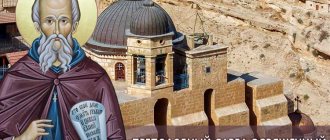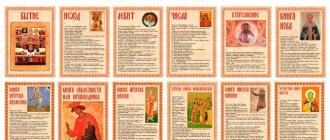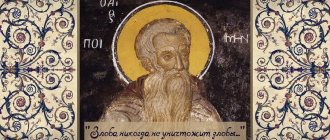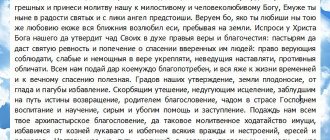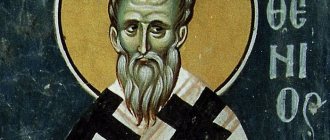For the Orthodox, the New Year is September 1 according to the Julian calendar.
The beginning of the year in religious circles is sometimes called the indict, and sometimes the New Year. And it falls not at the beginning of January, but on September 1, i.e. the 14th according to the old style. It is from this day that the cycle of church events begins.
Many believers believe that the Orthodox New Year does not exist as such, but that there is a secular holiday with which they are trying to replace and overshadow the bright day of the Nativity of Christ. Others argue that the Old New Year on January 13 can be considered pleasing to the church. So where is the truth?
history of the holiday
In 988 AD. Prince Vladimir the Great baptized Kievan Rus. Along with the new faith came a new Byzantine chronology. From now on, the countdown began from the Creation of the world. The onset of the new year was celebrated on the first day of spring, celebrating the arrival of warmth and the revival of nature after a long winter hibernation.
Only in 1942 was the Orthodox Church able to ensure that the secular New Year was moved to the fall. The Orthodox world celebrates the New Year according to the church calendar in September. In 2022 they will celebrate the year 7528 from the creation of the world and people by God. The cycle begins with the Birth of the Virgin Mary, which falls on September 21 according to the new style, and ends with the Assumption on August 28.
Interesting fact: the first schools and educational centers were opened at churches and monasteries. Since then, a tradition has emerged to begin the school year on September 1, on the New Year's holiday, although according to the new style this day falls on the 14th.
The first Emperor of Russia, Peter the Great, impressed by his travels in Europe, decided to introduce a calendar similar to the European one, but the church calendar remained the same. Thus, the celebration of the New Year took place after the end of the Nativity Fast. Magnificent festivities and feasts did not in any way prevent ordinary people from remaining pious Christians.
In 2022, after the revolution and the transition to the Gregorian style, Christians faced a huge problem: the new chronology made it difficult to carry out fasting with dignity. With the Soviets coming to power, the church fell out of its sphere of influence for many decades. Communism extremely condemned the manifestation of religious impulses. Instead of church holidays, they introduced their own, Soviet ones.
In the 1920s, the Bolsheviks fought against the tradition of setting up and decorating Christmas trees for the New Year.
Due to the cancellation of Christmas trees and children's matinees, workers staged strikes and illegal events. During the time of Stalin, who wanted to celebrate only 2 revolutionary events, the situation escalated to the extreme. It was possible to reach some kind of compromise by introducing an official day off and holiday on January 1st.
In 1935, it was allowed to put up a Christmas tree, and Christmas paraphernalia was henceforth called New Year's.
We also inherited from the USSR the tradition of considering the New Year a more significant holiday, giving gifts on January 1, and not on December 7 or even December 25.
Folk signs for February 19, 2022
- Frosts on this day - expect a stormy spring, dry and hot summer.
- The golden color of dawn and the violet color of the horizon mean good weather.
- Lap dogs climb onto sofas, curl up, cover their noses with their paws and sleep - it’s freezing.
- Tobacco gets damp - to snow.
- Dry leaves rustling on the trees mean snowfall.
- Field mice have crawled out of their holes and are running in the snow - a sign of cloudy weather.
- The colder it is on Vukola-calf, the warmer it is in March.
- If there is a thaw on this day, the cows will not milk well.
- If two calves are born of the same color, this is a good omen. Calves of different colors mean trouble.
- If a cow sleeps with her head facing east, she will calve during the day. To the west - in the evening and at night, respectively.
- The best food on this day went to pregnant cows and pregnant sheep - so that they would be full, happy and bear good offspring.
- If a cow calved, a bucket of warm water was placed in front of her to keep the milk warm.
- The little calf had to be brought into the house so as not to catch a cold.
- The housewives of Vukola were burning thyme in the barn. The smoke from this herb was believed to affect the taste and quality of milk, as well as the health of newborn calves. They did the same with the sheepfold.
- A newborn calf should not be stroked on the back, otherwise it will get sick.
- As soon as cow's milk after calving became suitable for drinking, housewives cooked porridge from it, charming it for successful and numerous offspring, for the health of cows and small calves, as well as for tasty milk.
- If a single person prays earnestly on this day, he will soon find a mate.
- You should not lend anything from home - it is not good.
- A dream seen from February 18 to 19 will come true 8 days later. You cannot tell anyone about what you saw in the kingdom of Morpheus.
- Dreams that occurred during the day on February 19 will come true in 6 years. There is no need to talk about them either.
Opinion of the modern Russian Orthodox Church
The Russian Orthodox Church is categorically against the holiday, because of which believers break the Nativity Fast. The Church believes that the New Year has a negative impact on Christian values and corrupts them: instead of fasting and praying, purifying themselves physically and spiritually, parishioners drink alcoholic beverages, indulge in gluttonous sinful food, and get carried away by entertainment and amusements.
The Holy Fathers insist that New Year's unbridled drunkenness and excessive fun are relics of the atheistic Soviet past, and the figures of Father Frost and the Snow Maiden are even called echoes of paganism.
Particular outrage among clergy is caused by the newfangled custom of celebrating the year of the animal according to the Chinese calendar and dressing in fancy dress.
An alternative offered by Orthodox churches is to go to the church to listen to prayer services and pray yourself and give alms. Families with children are advised to accustom the child to the idea that gifts are brought by Saint Nicholas, and not by a pagan wizard.
Thoughts about a magnificent celebration, according to the church, are tests sent by the evil one to test faith.
Thoughts about a magnificent celebration, according to the church, are tests sent by the evil one to test faith. Only a true believer will be able to resist temptations, but preserve the divine spark of love in his heart and humbly obey the Orthodox canons.
Radical Orthodox publications encourage parishioners to become like the early Christians and resist existing social rules.
Arguments against celebration
All Orthodox objections to the intention to celebrate the New Year with celebrations can be summarized by the following theses:
- the fast is broken;
- non-believers behave immorally on winter holidays;
- there are many temptations for fragile souls;
- New Year's traditions were imposed by blasphemous communists;
- Christians can celebrate the New Year as their own holiday;
- New Year's fireworks and masquerades are obscurantism;
- the persona of Santa Claus is copied from a pagan deity, etc.
New Year celebration traditions
Each custom has its own history and carries a specific meaning.
- At the center of the celebration is always the New Year tree - an integral attribute of the holiday. The tradition of decorating houses with fir branches dates back to the time of Peter the Great, who sought to imitate Europe in everything.
- They began decorating the evergreen tree at the end of the 19th century. The custom was taken from the German people. In ancient times, apples, nuts and various homemade toys were hung on Christmas trees. Each such object symbolized something specific.
- In Germany in the 17th century, glass balls appeared, which served as the prototype for today's jewelry. In the city of Lausha in 1867, the first enterprise for the production of Christmas tree decorations was built.
- In Scandinavia, a tradition arose of decorating the top of the tree with the figure of the Savior, which was later replaced by an angel. In the USSR, a red communist star burned at this place. However, in the Christian tradition, the star was associated with the moment of the birth of the Messiah near the city of Bethlehem.
- The fashion for the appearance of jewelry was constantly changing. Shiny tinsel was replaced by toys in silver tones or made of cardboard.
- Not a single New Year is complete without gifts, which are wrapped in beautiful boxes and placed under the tree at night. In the morning they are found by children filled with joy. Legend has it that gifts are brought by Father Frost, whose prototype is St. Nicholas the Pleasant, with his granddaughter Snegurochka. The latter was invented by the writer A. Ostrovsky.
St. Basil's Day
For years, non-believers and Christians celebrated the event on January 13th. But if the former celebrate the New Year holiday simply according to the old style, then for the latter it is the day of memory of Basil the Great.
Historical information: Basil the Great lived in the 4th century. n. e. Born into a family of convinced Christians. He received an excellent education: he studied rhetoric and philosophy, astronomy, mathematics and medicine. Later he took church orders and devoted many years to writing theological works.
For his piety demonstrated during his lifetime, he was canonized posthumously. The relics are kept in the Athos Lavra, and the right hand is kept in the Jerusalem Church of the Resurrection of Christ.
“Can Orthodox Christians celebrate the New Year?”: Church calendar for December 31
December 31 (December 18 according to the “old style” - the church Julian calendar). Thursday of the 30th week of Pentecost (thirtieth week after the Feast of the Holy Trinity). Christmas post. Despite the upcoming civil New Year (New Year), the church charter at meals only blesses Lenten food with vegetable oil. But it is not forbidden to drink a little wine (or, according to the secular New Year's tradition, champagne). Today the Russian Orthodox Church commemorates 26 famous saints by name.
Today, before we talk about the saints of this day, we will answer a question that is asked every year on New Year’s Eve. Moreover, both from people who are churchgoers and those who are on the way to the Church. So:
Is it possible for an Orthodox Christian to celebrate the civil New Year?
The answer is simple: not only is it possible, but it is necessary. And not only so as not to confuse non-believers with his ostentatious piety. Thus, in the churches of the Russian Church there is even a special prayer service for the New Year, and in some churches it is even celebrated directly on New Year’s Eve. This is in no way stipulated by the Church Charter, but was established solely for the purpose of not getting drunk at the festive table at this time and not violating Lenten food restrictions. And at the same time - for the sake of conciliar prayer for the coming year. Although, of course, any superstitious expectations associated with the New Year are contrary to the Christian faith. In this sense, December 31 is no different from January 1, as well as from any date in February or March.
And now regarding the already mentioned Lenten restrictions on New Year’s Eve. Yes, they are quite strict. So, in 2022, on December 31, according to the statutory regulations, only Lenten food with vegetable oil is blessed. But this means that drinking a little wine or champagne is not forbidden. But on January 1st there is a stricter fast - without vegetable oil, and, accordingly, wine. Therefore, it is quite possible to spend the old year with a glass of champagne with a Lenten snack, if you wish, listen to the speech of the Russian head of state on TV and go to bed.
Well, on January 1 in the morning it would be good to go to the nearest church for a service. Or, if opportunities and budget allow, on a short pilgrimage trip. Unless, of course, this is prevented (as this year), for example, by the same sanitary and epidemiological restrictions. As for entertainment, it is better to abstain from it. Although going to museums or the skating rink with children is not prohibited. However, in such everyday cases the importance of an experienced confessor is determined: it would be useful for a believer to consult about this with a priest.
* * *
Martyr Sebastian of Milan. Photo: www.pravoslavie.ru
Martyr Sebastian of Milan, Nicostratus, Zoe, Castorius, Tranquillinus the presbyter, deacons Marcellinus and Mark, Claudius, Symphorianus, Victorinus, Tivurtius and Castulus . Holy sufferers who accepted the crown of martyrdom in Rome for their loyalty to Christ and His Church during the years of pagan anti-church persecution of the co-emperor emperors Diocletian (Diocletian) and Maximian, who reigned in 284–305 from the Nativity of Christ. Saint Sebastian was the chief of the palace guard, a man of honor and a brave warrior, who was sincerely respected by his subordinates. Being a secret Christian, he tried to support his brothers in faith in everything. Thus, having learned that the arrested Christian brothers Markellinus and Mark, under pressure from their pagan mother, had wavered in their loyalty to Christ, he came to them and uttered heartfelt words:
Valiant warriors of Christ! Do not throw away the banner of your victories for the sake of women’s tears and do not weaken the enemy who has been brought down under your feet, so that, having received strength again, he does not begin to fight with you. Erect the glorious banner of your feat above earthly passions. If those whom you see crying knew that there is another life - immortal and painless, in which unceasing joy reigns - then they would certainly want to enter into it with you and, despising temporary life, would try to obtain eternal life. He who does not want to be a servant of eternal life will also destroy this temporary life in vain.
This strengthened the holy brothers, and they decided to undertake martyrdom. But the royal guardian Nicostratus, whose wife Zoe was healed by Saint Sebastian, gave the order to release Marcellinus and Mark. Having learned about the miracle, the head of the Roman prisons, Claudius, also believed in Christ. As a result, the Christian priest Polycarp, called by them, baptized Father Marcellian and Marcus Tranquillinus, his relatives and friends, Nicostratus and his family, Claudius and his sons, as well as 16 condemned prisoners. In total there were 64 newly baptized people. Soon many of them, including Saints Sebastian, Nicostratus, Zoe, Castorius, Tranquillinus the presbyter, deacons Marcellinus and Mark, Claudius, Symphorianus, Victorinus, Tiburtius and Castulus, suffered for the faith. After terrible torture, they were executed in 287 or 304 AD (the exact date is unknown).
* * *
Saint Modest, Archbishop of Jerusalem . First Hierarch of the Jerusalem Orthodox Church of the first half the 7th century AD, a time when the Christians of the Holy City of Jerusalem and its environs suffered greatly from the invasion of the Persian king Chozroes, whose troops, united with the Jews, killed 90 thousand Christians in 614 and destroyed many Christian shrines.
Bishop Modest, thanks to the help provided by the Patriarch of Alexandria, Saint John the Merciful , was able to restore the destroyed Christian churches, including the main shrine - the Church of the Holy Sepulcher. The saint departed to the Lord at the age of 97 in the year 634 from the Nativity of Christ.
Saint Modest of Jerusalem. Photo: www.pravoslavie.ru
Venerable Florus, Bishop of Amia . A high-ranking courtier of the emperor of the Roman kingdom (Byzantium), Saint Florus, having experienced a family tragedy (his wife and children died of smallpox), left the world for the sake of monastic solitude. Subsequently, this righteous man was elected Bishop of Amiya. The saint died peacefully at the beginning of the 7th century from the Nativity of Christ.
Rev. Michael Singel, Constantinople, confessor . This saint of the 9th century was a Constantinople priest and church official (head of church administration affairs). Under the heretical iconoclast emperors Leo the Armenian and Theophilus, who reigned in the Roman Empire (Byzantium) in 813–820 and 829–842 AD , he suffered a lot for the defense of the true faith.
After the pious Empress Theodora (the widow of the deceased wicked Theophilos) revived Orthodox icon veneration, Father Michael was offered to become Patriarch, but out of humility he remained in his previous position, in which he departed to the Lord in 845 from the Nativity of Christ.
Venerable Sebastian of Sokhot, Poshekhonsky . Russian saint of the 15th century , founder of a monastic monastery in honor of the Transfiguration of the Lord on the Sokhoti River, 90 versts from the city of Romanov (now the city of Tutaev, Yaroslavl region). The brethren of the monastery, together with their abbot, fully provided themselves and the monastery with the fruits of their own labors. Saint Sebastian departed to the Lord in 1500 from the Nativity of Christ.
* * *
Glorification of the righteous Simeon of Verkhoturye . The great Russian righteous man of the first half the 17th century , a nobleman who hid his origins and led the humble life of a poor man. The life of this saint testifies:
He walked around the villages and sewed sheepskin coats and other outerwear for free, mainly for the poor. At the same time, he deliberately left something unfinished—either sleeves or a collar—for which he suffered reproaches from customers. The ascetic traveled a lot, but most often lived in the graveyard of the village of Merkushinsky not far from the city of Verkhoturye. In his free time from work, the saint loved to fish in the quiet of solitude, for it reminded him of the disciples of Christ, whose work he continued, instructing local residents in the true faith...
The holy righteous Simeon of Verkhoturye went to the Lord very young, in the 36th year of his earthly life, in 1642 from the Nativity of Christ. And already in 1694 he was glorified as a saint.
Righteous Simeon of Verkhoturye. Photo: www.pravoslavie.ru
* * *
Martyr Victor Matveev (1936), Hieromartyrs Thaddeus (Uspensky), Archbishop of Tver, Nikolai (Klementyev), Archbishop of Veliky Ustyug, Elijah Benemansky, John Mironsky, Vladimir Preobrazhensky and Nikola Kobranov, presbyters (1937), Hieromartyr Sergius Astakhov, deacon, and martyr Vera Trux (1942) . All these holy sufferers in the ranks of bishops, priests and deacons, as well as laywomen, accepted death for loyalty to Christ and His Church during the period of Soviet atheistic persecution. Each of them was glorified as saints in the thousands of new martyrs and confessors of the Russian Church.
* * *
Congratulations to Orthodox Christians on the upcoming civil new year (New Year) and the memory of all today's saints! Through their prayers, Lord, save and have mercy on us all! We are happy to congratulate those who received names in their honor through the Sacrament of Holy Baptism or monastic tonsure! As they used to say in Rus' in the old days: “For the Guardian Angels - a golden crown, and for you - good health!”
Folk traditions
Have you already thought about the New Year's menu?
Not really
Lent is over, so quick meals are allowed. Kutya and dumplings with cottage cheese were always prepared for the table. Unlike Christmas sochiv, generous kutya does not need to be made lean.
From the middle of the night, boys go from house to house and sprinkle grain on their owners, making wishes. For this they are thanked with small monetary rewards and sweets. Of course, this tradition looks like a pagan one, but there is nothing bad in it if part of the “sown” money is given out as alms or taken to church.
Features of the celebration
On New Year's Eve, families gather around a luxurious table decorated with various delicacies. People strive to look formal and dress in new, bright clothes. In secular society, it is customary to celebrate this day on a grand scale, which will create a favorable foundation for the future.
- Nowadays, celebrations in cafes or restaurants are becoming widespread. Professional presenters are invited here, interesting competitions and intriguing events are organized.
- Many people believe that wishes made during the chiming clock come true. Since 1970, Russia has introduced the tradition of congratulations on behalf of the head of state.
- On New Year's Eve, fireworks are launched, coloring the sky with intricate patterns. People walk around the city with sparklers and explode specific firecrackers. This tradition was known back in China and symbolized the expulsion of evil spirits.
On the celebration of other secular holidays:
- About the celebration of March 8
- About Valentine's Day
How to celebrate for the Orthodox
Even if you are an ardent believer, you should not enter into conflicts with those who disagree, argue and show aggression, scare you with hell, etc. Philip’s fast is a time to pacify passions and your own pride, show patience and love not only for God, but also for your neighbors . The ways of the Lord are mysterious, as he pleases, so it will be.
A particularly sensitive question is whether a child should be allowed to attend the New Year's party with friends and classmates from non-religious families. Psychologists and priests unanimously insist that it is not worth depriving a child of a holiday, because due to coercion, he is more likely to become angry with his parents and the church than to reconcile.
Attention! Doctors prohibit children, the elderly and the sick from participating in strict fasting. Be sure to consult a doctor, and only after that ask for blessings from your spiritual mentor.
Separation from the team and prohibitions are perceived as unfair punishment. This is also important from the point of view of socialization: no one wants to be an outcast.
Interesting facts about the new year.
Customs and traditions of February 19
If Saint Agafya (February 18) is considered the patroness and savior of cows, then Saint Vukol protected newborn calves.
Vukols are calf breeders.
Beetles (cows) calve on Saint Vukola.
On Vukola - the beginning of the spring calving of cows.
Vukola will come, all the beetles will calve.
The main concern of the peasants during this period was to preserve the health of the cow and calf. The calving cow in the barn was fumigated with thyme (Bogorodskaya grass, thyme) so that there would be good milk and the young animals would grow healthy.
In many villages, the ritual of “praying milk” was performed. After the cow calved and after twelve milk yields, when the colostrum has passed and the milk becomes fit for consumption, a mild porridge was cooked on it before dinner. The eldest woman in the family took a pot of porridge, lined it with hay and placed it in a bowl of oats. Then she raised this cup above her head three times and each time said: “For a hundred bulls!” For a thousand heifers! While the hostess performed the ceremony, other family members prayed to God. Then they removed the films from the porridge and sat down at the table to dine. Oats and hay were given to the cow and heifer, and film from the porridge was given to the calf.
In villages, healers distributed pieces of salted bread to housewives, over which they read spells for easy calving. The born calf was wiped with a towel from the tail to the neck and said:
“My master, grandfather of the house, take this little calf as your neighbor, don’t offend him and don’t let others offend you.”
A newborn calf was brought into the house so that it would not catch a cold. According to legend, you should not stroke a calf on the back, otherwise it may get sick.
On the day when a cow is calving, you cannot give anything from the house to anyone - no money, no bread, no fire, no water, lest along with them you give away the profit sent by the Lord to the house. It is worth noting that these rules were observed even in the case when a woman gave birth, a cow foaled, a sheep lambed, a pig was pigleted, and even on the days of sowing grain. “Now is not the time,” the owners answered the person who came to borrow something. No one was offended by such a statement, because he himself did the same under similar circumstances.



